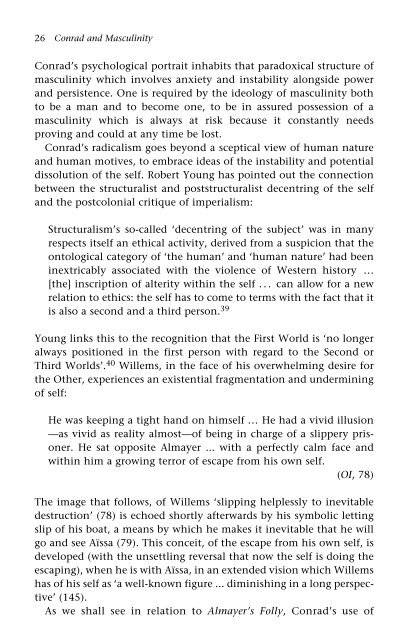Conrad and Masculinity
Conrad and Masculinity
Conrad and Masculinity
You also want an ePaper? Increase the reach of your titles
YUMPU automatically turns print PDFs into web optimized ePapers that Google loves.
26 <strong>Conrad</strong> <strong>and</strong> <strong>Masculinity</strong><br />
<strong>Conrad</strong>’s psychological portrait inhabits that paradoxical structure of<br />
masculinity which involves anxiety <strong>and</strong> instability alongside power<br />
<strong>and</strong> persistence. One is required by the ideology of masculinity both<br />
to be a man <strong>and</strong> to become one, to be in assured possession of a<br />
masculinity which is always at risk because it constantly needs<br />
proving <strong>and</strong> could at any time be lost.<br />
<strong>Conrad</strong>’s radicalism goes beyond a sceptical view of human nature<br />
<strong>and</strong> human motives, to embrace ideas of the instability <strong>and</strong> potential<br />
dissolution of the self. Robert Young has pointed out the connection<br />
between the structuralist <strong>and</strong> poststructuralist decentring of the self<br />
<strong>and</strong> the postcolonial critique of imperialism:<br />
Structuralism’s so-called ‘decentring of the subject’ was in many<br />
respects itself an ethical activity, derived from a suspicion that the<br />
ontological category of ‘the human’ <strong>and</strong> ‘human nature’ had been<br />
inextricably associated with the violence of Western history ...<br />
[the] inscription of alterity within the self . . . can allow for a new<br />
relation to ethics: the self has to come to terms with the fact that it<br />
is also a second <strong>and</strong> a third person. 39<br />
Young links this to the recognition that the First World is ‘no longer<br />
always positioned in the first person with regard to the Second or<br />
Third Worlds’. 40 Willems, in the face of his overwhelming desire for<br />
the Other, experiences an existential fragmentation <strong>and</strong> undermining<br />
of self:<br />
He was keeping a tight h<strong>and</strong> on himself ... He had a vivid illusion<br />
—as vivid as reality almost—of being in charge of a slippery prisoner.<br />
He sat opposite Almayer ... with a perfectly calm face <strong>and</strong><br />
within him a growing terror of escape from his own self.<br />
(OI, 78)<br />
The image that follows, of Willems ‘slipping helplessly to inevitable<br />
destruction’ (78) is echoed shortly afterwards by his symbolic letting<br />
slip of his boat, a means by which he makes it inevitable that he will<br />
go <strong>and</strong> see Aïssa (79). This conceit, of the escape from his own self, is<br />
developed (with the unsettling reversal that now the self is doing the<br />
escaping), when he is with Aïssa, in an extended vision which Willems<br />
has of his self as ‘a well-known figure ... diminishing in a long perspective’<br />
(145).<br />
As we shall see in relation to Almayer’s Folly, <strong>Conrad</strong>’s use of




